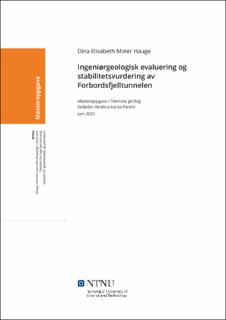| dc.contributor.advisor | Panthi, Krishna Kanta | |
| dc.contributor.author | Hauge, Dina Elisabeth Moter | |
| dc.date.accessioned | 2022-09-28T17:43:07Z | |
| dc.date.available | 2022-09-28T17:43:07Z | |
| dc.date.issued | 2022 | |
| dc.identifier | no.ntnu:inspera:114862279:35324857 | |
| dc.identifier.uri | https://hdl.handle.net/11250/3022401 | |
| dc.description.abstract | I forbindelse med utbygging av ny E6 i Trøndelag skal det etableres toløpstunnel gjennom Forbordsfjellet. Ved utgraving av underjordsåpninger vil bergmassen rundt åpningen bli preget av endrede spenningsforhold og deformasjoner. Avstanden mellom løpene vil være avgjørende for hvordan utgravingene påvirker hverandre. Å bestemme optimal avstand mellom tunnelløpene vil være viktig for å oppnå stabile bergforhold og redusere sikringskostnader. For Forbordsfjelltunnelen er numeriske metoder benyttet for å undersøke pilarbredder på 10 m, 15 m og 20 m. Ved avstander på 10 m og 15 m viste den numeriske modelleringen brudd-dannelse i bergmassen over pilaren. Brudd-dannelsen reduseres ved økning av pilarbredden, og ved en bredde på 20 m forekommer det ikke brudd i bergmassen over pilaren. En 20 m pilarbredde medfører også en spenningsfordeling i pilaren som er mest lik in-situ bergspenningene, og en pilarbredde på 20 m regnes derfor som det gunstigste alternativet.
Ved påhuggområdet er det planlagt en avstand mellom tunnelløpene på 8 m. Basert på krav til horisontalkurveradius vil en pilarbredde på 20 m oppnås ved en avstand på 100 m fra påhugget. Før det oppnås tilstrekkelig pilarbredde, kan ekstra sikring av tunnelene være nødvendig for å sørge for stabilitet.
Bergoverdekningen og spenningssituasjonen ved tunnelnivå henger tett sammen. Overdekningen varierer fra kun få meter ved påhuggsområdene til opp mot 470 m. Empiriske, analytiske og numeriske metoder er benyttet ved gjennomføring av stabilitetsvurderingen langs tunneltraseen. Det forventes ikke problemer relatert til høye bergspenninger, verken bergslag eller avskalling i hardt og massivt berg, eller store deformasjoner ved driving gjennom svakt berg. Ved driving gjennom kryssende svakhetssoner og bergartsgrense vil tyngre bergsikring kunne være nødvendig for å begrense deformasjonen og brudd-dannelsen rundt tunnelløpene.
Ved lav bergoverdekning forventes redusert innspenning av tunnelhenget. Redusert innspenning, kombinert med registrerte sprekkesett fra feltkartlegging, vil ifølge analyser fra UnWedge kunne resultere i nedfall av blokker og kiler fra tunnelens heng og vederlag. Dette vil i stor grad være tilfellet ved påhugg nord i Langsteindalen. Ved installasjon av bergsikring vil det være mulig å oppnå tilstrekkelig sikkerhetsfaktor og stabile forhold. | |
| dc.description.abstract | As part of upgrading the existing E6 highway in Trøndelag, a two-tube tunnel is planned through Forbordsfjellet. Excavations of underground openings will affect the rock mass around the opening and cause displacement and modification of the initial rock stresses. The distance between the adjacent tubes will determine to what extent the affected rock mass will overlap. Deciding on an optimal distance between the tubes will be important to accomplish stable rock conditions and reduce costs related to rock support. Numerical modelling has been used to assess pilar width of 10 m, 15 m, and 20 m for the adjacent tubes through Forbordsfjellet. Pilar widths of 10 m and 15 m resulted in a yielded zone in the rock mass above the pilar. The extend of yielding above the pilar was reduced with increasing pilar width, and a width of 20 m resulted in no yielding in the rock mass above the pilar. The stress distribution in the pilar was also the most similar to in-situ rock stresses when using a pilar width of 20 m, and thus this width is assumed to be the most favorable.
The distance between the adjacent tubes is planned to be 8 m at the portal area. Based on requirements from the Norwegian Public Roads Administration regarding the radius of horizontal curvature, a pillar width of 20 m is obtained at a distance of 100 m from the portal area. To ensure stable rock conditions, extra rock support might have to be installed prior to having sufficient pillar width.
Rock cover and stress conditions at tunnel depth are closely related. The rock cover at Forbordsfjellet Tunnel varies from just a few meters at the portal area to 470 m. Empirical, analytical, and numerical methods have been used to assess the stability along the tunnel alignment. Problems related to high rock stresses are not anticipated, neither rock burst or spalling in hard rock, nor squeezing and large deformation of soft rock. Heavy rock support might be necessary to limit rock failure and displacement when excavating through weakness zones and changing geological conditions.
Limited rock overburden can result in very low rock stresses around an underground opening. Low rock stresses and several joint sets found from field mapping can, according to the UnWedge-analysis, result in blocks and wedges falling out. This is the case for the northern portal area in Langsteindalen. The analysis shows that installation of rock support will help achieve a sufficient factor of safety and tunnel stability. | |
| dc.language | nob | |
| dc.publisher | NTNU | |
| dc.title | Ingeniørgeologisk evaluering og stabilitetsvurdering av Forbordsfjelltunnelen | |
| dc.type | Master thesis | |
